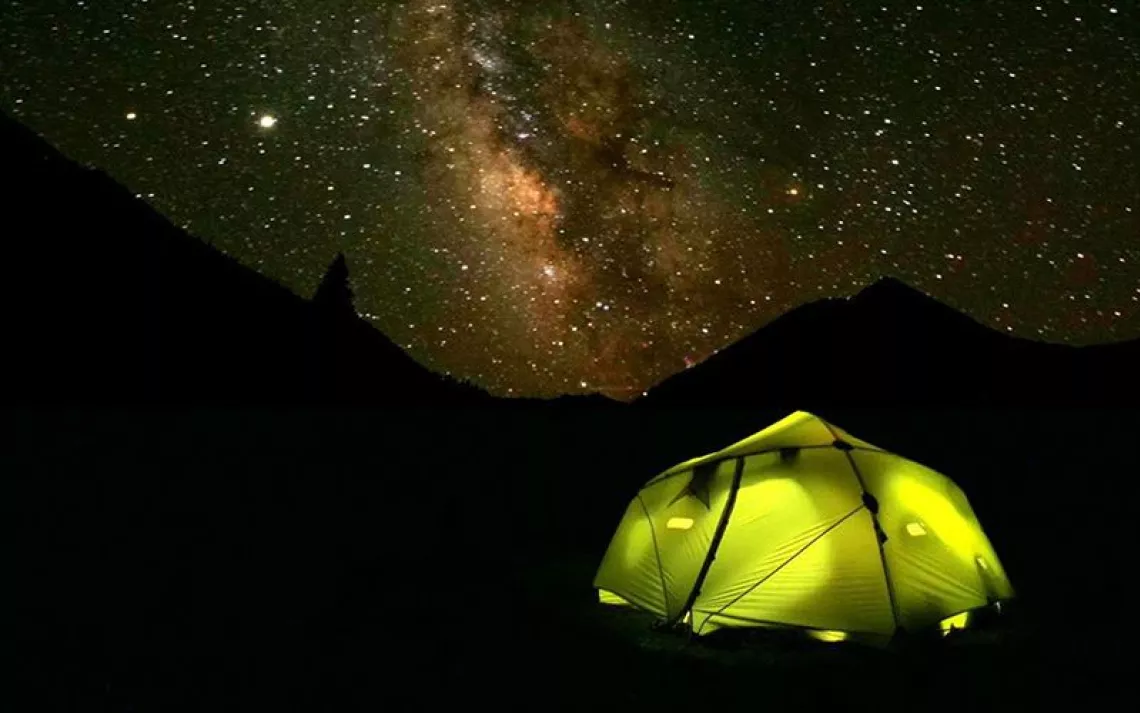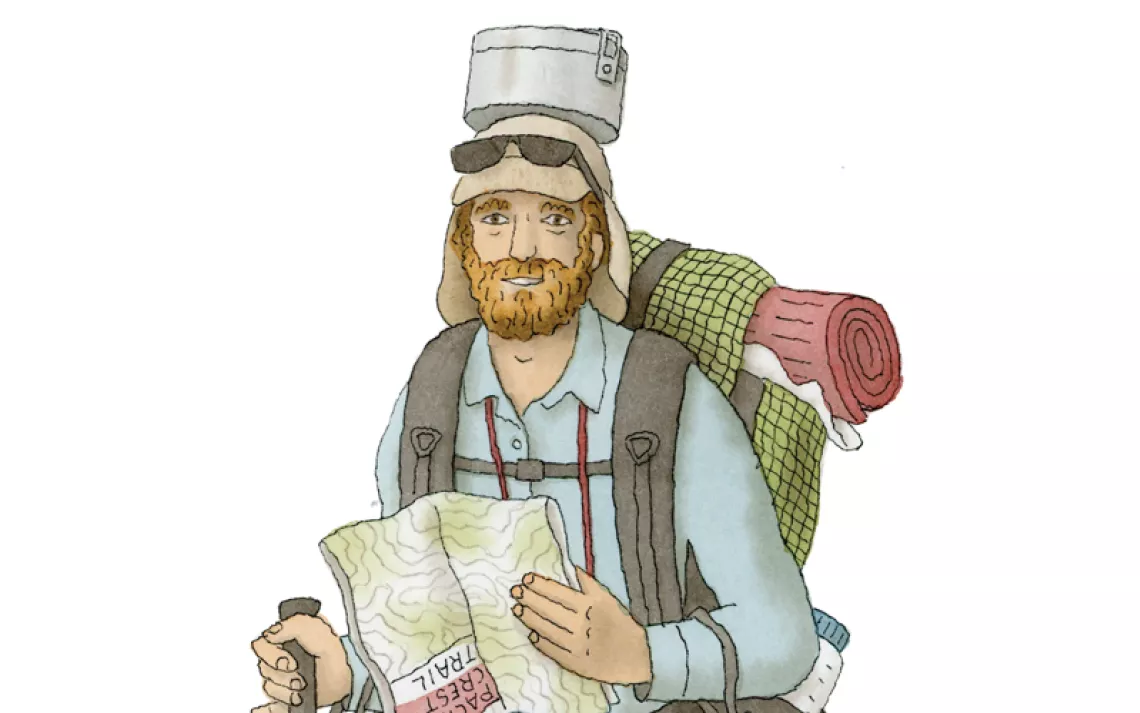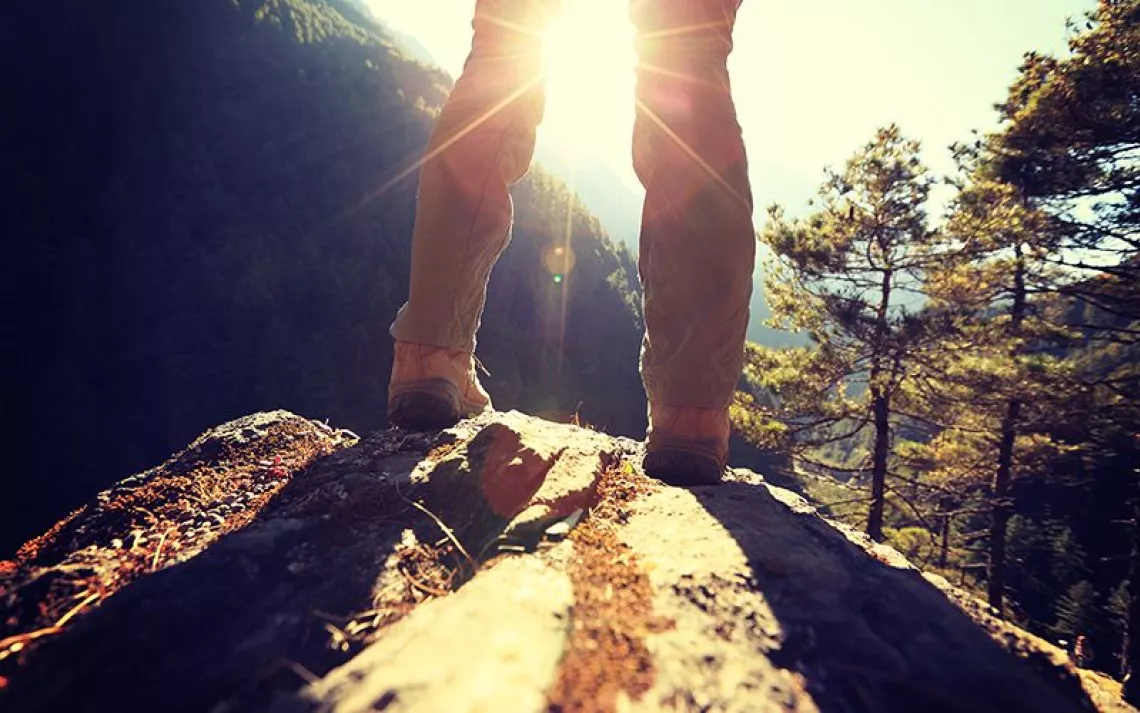Pack It In, Pack It Out: Lessons From Backpacking With Llamas
Pack animals make wilderness glamping possible

Photos by Alexia Chimenti
The folding table turned out to be a bridge too far. Each of the llamas was supposed to be able to carry 60 pounds, and we had rented two, giving us an extra 120 pounds beyond what we’d carry ourselves. We figured that 120 pounds would be more than enough for essentials—all of the food and some of the gear—as well as choice extravagances. During our pre-trip preparations, everyone agreed that we would have plenty of pack space on the llamas for “toys.” That meant fishing gear for the rainbow and brown trout we heard were biting after the long winter or an ice axe in case anyone was interested in a little bit of mountaineering along the still-lingering snow fields. But as we began loading the saddlebags, it quickly became obvious that we were going to hit the llamas’ weight limit. The collapsible table would have to stay.
I’ll admit that bringing a table into the wilderness is kind of a silly idea. But from the beginning, this particular Fourth of July wilderness trip had been conceived of as more indulgent getaway than adventurers’ expedition. There were 10 of us, including my two-year-old daughter and my 69-year-old mother-in-law, and the pack llamas were supposed to be a kind of backpacker’s life-hack—a way to get into the backcountry without as much back-breaking effort. Cooking food for 10? The table would come in handy, I figured. The llamas would be like pack-weight alchemists, turning luxuries into necessities.
When I began dreaming up the llama-assisted backpacking trip in the dark of winter—with rain hammering coastal California and the snow piling up in the Sierra—I imagined it as one of those Sierra Club High Trips of a century ago. Maybe you’ve seen some of the black-and-white pictures from such trips. There were scores of people of all ages on weeks-long treks in the Alpine paradise, accompanied by long mule-trains. The old High Trips strike me as the very model of what some people have started to call “glamping”: every family with a big canvas tent, instruments galore, and big, metal washtubs, and potatoes (can you think of a heavier food item?) as part of supper. The llamas would give us the 21st-century version. The llamas would make the trip.
For the most part (the left-behind table notwithstanding), it all went according to vision. The Emigrant Wilderness was postcard-perfect: the peaks still capped with white after the epic winter storms, the snow melt pouring into ox-bowed creeks. The trek up to Kennedy Lake was easy enough, and even though the hanging valley of Kennedy Creek was a busy and crowded wilderness, it wasn’t difficult to find a good campsite. My daughter, on the second backpacking trip of her life, took it all effortlessly. My mother-in-law, on the first backpacking trip of her life, was beside herself with delight. The whole group slipped into mountain time. A few of us fished. Most everyone went swimming in the clear, frigid waters. My friend Alexia spent her afternoons making watercolors of the wildflowers: shooting stars, phlox, and paintbrush.

Sign up to receive Sierra News & Views
Get articles like this one sent directly to your inbox weekly.
With this action you affirm you want to receive Sierra Club communications and may vote on policy designated by the Sierra Club Board.
While I wouldn’t go so far as to say the llamas were great companions—they remained wary of us the whole time and seemed to understand that this was a purely transactional relationship—they were good entertainment. Whenever I needed to head off a toddler tantrum, the llamas made for the perfect distraction. By day two, my daughter was referring to Linda, an eight-year-old white, and Chanteuse, a four-year-old brown, as “Lily’s llamas.” All of the other backpacking groups we passed wanted to stop for llama selfies or to ask llama trivia. One day-hiker mansplained to me that the Spanish conquered the Incas because llamas are fearful of horses. Never mind the dubiousness of this claim (see: influenza), it contradicted our own lived experience. Whenever we crossed paths with horse groups, the horses acted far more skittishly than the llamas, which took the encounters with quiet aplomb. The wranglers from the Kennedy Meadows pack station gave us the stink eye. This seemed to be as much warning to keep our animals in hand as belittlement of our livestock choice, the llama being a kind of backcountry cultural signifier—the Prius of pack animals, as it were.

Even amid all of the good fun, something kept nagging at me: What, exactly, were we all carrying? The llamas were loaded with 120 pounds, and still every adult had a full pack; even me, with my daughter on my back and the family tent strapped to her carrier. At one stream-crossing along the route into the high country, a guy watching us all huff past blurted out, “So what are the llamas carrying?”

The answer was too much food. As we’d find at the end of our four-day trip, a good 20 pounds too much. When we repacked the saddlebags for the return trip down the mountain, I was scandalized to find that we’d also be packing out close to 15 pounds of trash.
As if by some kind of inexorable law of thermodynamics—the Consumerist Accumulation Rule, you could call it—we had taken the extra weight afforded by the llamas and filled it beyond capacity. Just as nature abhors a vacuum, the emptiness of our packs clamored for stuff, and we dutifully obliged with too many unnecessary clothes, camp chairs, and watercolor paints. Looking at the big bag of trash, I felt like the backcountry version of the McMansion owner who still has a storage locker to hold his belongings. Where did all of this crap come from?
You can get away to the woods, I suppose, but it’s difficult not to bring the habits of a stuff-saturated life along the trail. Even when you try to leave everything at home and make a brief wilderness escape, you can end up taking your baggage with you.
Follow in the Writer’s Footsteps
Why llamas? First, they are easy to handle and good with kids, and there is little risk of injury from the animals. Because llamas are so accommodating, it’s easy to pick up the basics of llama-handling. Many other livestock outfitters require a handler to go along if you’re taking out their animals. With llamas, you don’t have to pay for a wrangler to come along on your wilderness trip.
Where can you rent llamas in California? We rented Linda and Chanteuse from Greg Harford at Potato Creek Llama Packers. Located outside the town of Sonora, California, just off Highway 108, Potato Creek is well located for Sierra Nevada destinations such as Emigrant Wilderness, Hoover Wilderness, Carson-Iceberg Wilderness, and Yosemite National Park. Harford conducts a two-hour training before sending you on your way.
Other llama resources. For those in other parts of the country, check out Rent-a-Llama (yes, that’s a thing), which has listings from outfitters nationwide.
Do llamas really spit? Yes, but usually only at other llamas that they perceive to be aggressive.
Pro-tip: Careful when wearing reflective sunglasses, as the llama might mistake its own reflection for a strange and hostile llama.
 The Magazine of The Sierra Club
The Magazine of The Sierra Club



